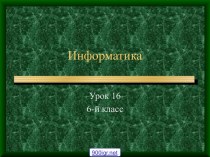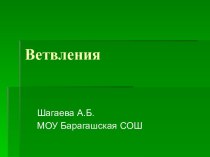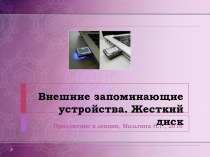- Главная
- Разное
- Бизнес и предпринимательство
- Образование
- Развлечения
- Государство
- Спорт
- Графика
- Культурология
- Еда и кулинария
- Лингвистика
- Религиоведение
- Черчение
- Физкультура
- ИЗО
- Психология
- Социология
- Английский язык
- Астрономия
- Алгебра
- Биология
- География
- Геометрия
- Детские презентации
- Информатика
- История
- Литература
- Маркетинг
- Математика
- Медицина
- Менеджмент
- Музыка
- МХК
- Немецкий язык
- ОБЖ
- Обществознание
- Окружающий мир
- Педагогика
- Русский язык
- Технология
- Физика
- Философия
- Химия
- Шаблоны, картинки для презентаций
- Экология
- Экономика
- Юриспруденция
Что такое findslide.org?
FindSlide.org - это сайт презентаций, докладов, шаблонов в формате PowerPoint.
Обратная связь
Email: Нажмите что бы посмотреть
Презентация на тему Microsoft Office Word 2007
Содержание
- 2. OFC335 Microsoft Office Word 2007 XML Programmability:
- 3. AgendaThe world today (Microsoft Office Word 2003)Structural IntegrityContent ControlsData/View SeparationMicrosoft Office XML data storeXML mappingConclusionQuestions
- 4. The World TodayWord 2003 was a major
- 5. The World of Word 2007Make it easier
- 6. Tristan Davis Program ManagerMicrosoft WordStructuring a Document
- 7. Content ControlsEvolution of customer-defined XMLNo XML schema
- 8. Tristan Davis Program ManagerMicrosoft WordXML Data Store / XML Mapping
- 9. Office XML Data StoreCustomer-defined XML (incl. WSS/Office
- 10. XML MappingLink document controls to nodes in
- 11. Tristan Davis Program ManagerMicrosoft WordMapping WSS Data Into Word
- 12. Mapping WSS Data into WordWord 2007 has
- 13. Client Side ProgrammingRecommended approach: program directly against
- 14. Tristan Davis Program ManagerMicrosoft WordUsing InfoPath for Client-Side Business Logic
- 15. Tristan Davis Program ManagerMicrosoft WordUsing Office OM for Client-Side Business Logic
- 16. Server Side ProgrammingRecommended approach: Using WinFX
- 17. Tristan Davis Program ManagerMicrosoft WordUsing Custom XML Data on the Server
- 18. Related Areas In VSTO V3Document control support
- 19. ConclusionTwo main themes to Word 2007 for
- 20. Key TakeawaysWord 2007 allows for more granular
- 21. Resources
- 22. The 2007 Microsoft Office System Clients. Servers.
- 23. Fill out a session evaluation on CommNet and Win an XBOX 360!
- 24. Скачать презентацию
- 25. Похожие презентации
OFC335 Microsoft Office Word 2007 XML Programmability: True Data/View Separation and Rich Eventing for Custom XMLTristan DavisProgram ManagerMicrosoft Corporation











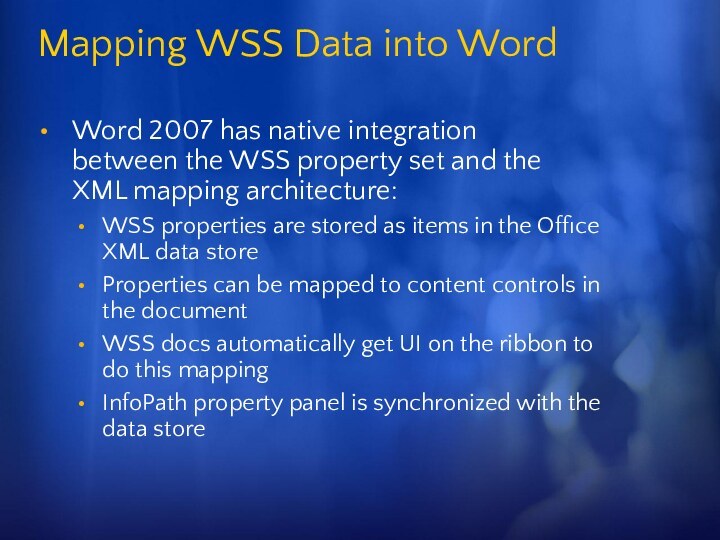


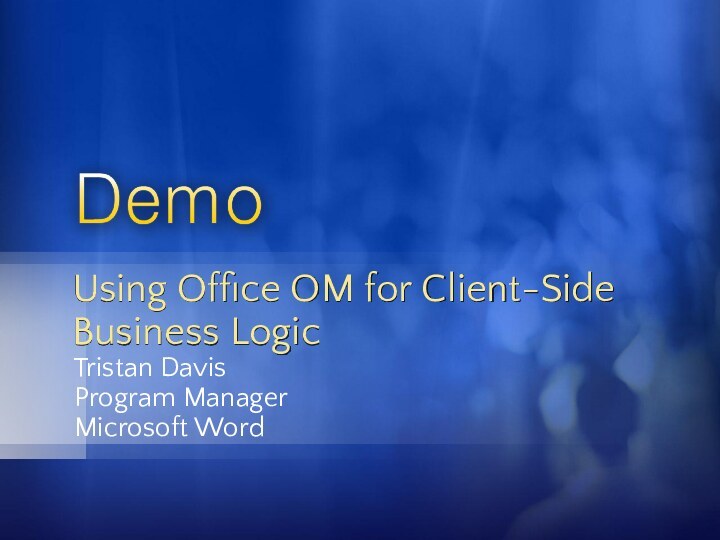




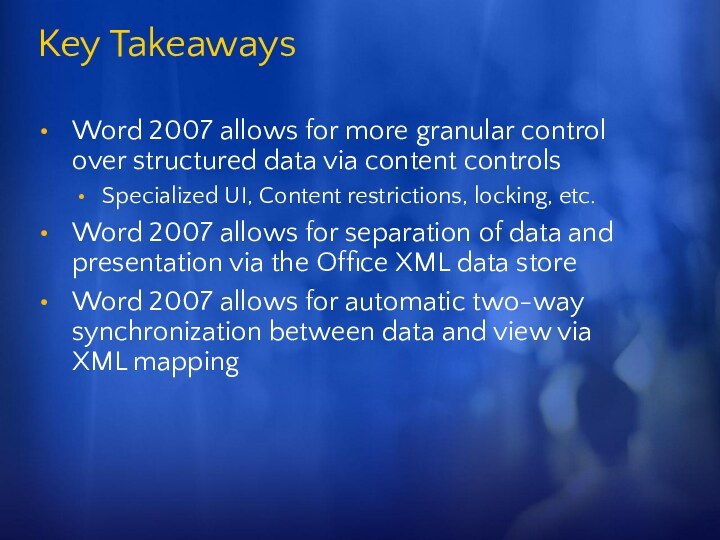




Слайд 2 OFC335 Microsoft Office Word 2007 XML Programmability: True Data/View
Separation and Rich Eventing for Custom XML
Corporation
Слайд 3
Agenda
The world today (Microsoft Office Word 2003)
Structural Integrity
Content
Controls
Data/View Separation
Microsoft Office XML data store
XML mapping
Conclusion
Questions
Слайд 4
The World Today
Word 2003 was a major step
forward:
XML-based file format (WordprocessingML)
Customer-defined schema support
However, a big toolbox
doesn’t mean it’s
easy to build a houseYou need XML schema, XSLT, client-side code, etc.
Слайд 5
The World of Word 2007
Make it easier to
push/pull customer data
within Word documents
How?
Structural integrity (Content Controls)
Provide
content restriction, lockdown capabilityData/view separation (Office XML data store)
Place to store custom XML data in the new file format
Each item is stored as a separate part within the package
Слайд 7
Content Controls
Evolution of customer-defined XML
No XML schema required
Provide
friendly end user exposure of
structured content
Each provides unique
content restrictions / user interface that doesn’t affect layoutControls can be grouped to lock them down as a unit
Controls can be mapped to XML data
Слайд 9
Office XML Data Store
Customer-defined XML (incl. WSS/Office doc
props) stored separately from WordprocessingML as a part in
Open XML formatAny XML can be stored (with or without XML schema)
XML data is available as an editable tree (using familiar DOM) within Word
Can be populated on a server using WinFX or a client using Word OM
Слайд 10
XML Mapping
Link document controls to nodes in the
XML data store
Provides for true data/view separation
model in
WordMappings are created using standard XPath expressions
Mappings can be set up to ‘auto-attach’ to incoming data
Out-of-the-box support for mapping to Office properties
Слайд 12
Mapping WSS Data into Word
Word 2007 has native
integration between the WSS property set and the XML
mapping architecture:WSS properties are stored as items in the Office XML data store
Properties can be mapped to content controls in the document
WSS docs automatically get UI on the ribbon to do this mapping
InfoPath property panel is synchronized with the data store
Слайд 13
Client Side Programming
Recommended approach: program directly against the
data
InfoPath or Office OM – your choice
Word will automatically
take care of the effects on the presentation via the XML mappingsUse shared error board to communicate validation errors to the user
Use controls OM if you need behavior for specific controls (e.g. to block user from exiting)
Слайд 16
Server Side Programming
Recommended approach:
Using WinFX to navigate
the file format
Adding a part is as simple as
adding a
single relationshipFinding an existing part is done by namespace or GUID matching
Слайд 18
Related Areas In VSTO V3
Document control support in
the Microsoft Visual Studio designer
Integration with .NET data binding
.NET
programming model for the XML data store for document manipulation on client/serverLeveraging the XML data store / new file format for VSTO solution storage
Слайд 19
Conclusion
Two main themes to Word 2007 for
solution
creation
Make structured document more robust by
providing controls and
content groupsProvide true data/view separation by providing custom XML data store
Result: you have to write less code and your solutions are more reliable with Word as the editing environment
Слайд 20
Key Takeaways
Word 2007 allows for more granular control
over structured data via content controls
Specialized UI, Content restrictions,
locking, etc.Word 2007 allows for separation of data and presentation via the Office XML data store
Word 2007 allows for automatic two-way synchronization between data and view via XML mapping
Слайд 22
The 2007 Microsoft Office System Clients. Servers. Solutions.
Install
Beta 2 today!
It’s in your attendee bag
Learn more
at the Office System TLC
Demo Stations / Hands-on-Labs / Chalk-talksGet more information
http://www.microsoft.com/office/preview/default.mspx
http://msdn.microsoft.com/office/
Talk
Lab
Demo

